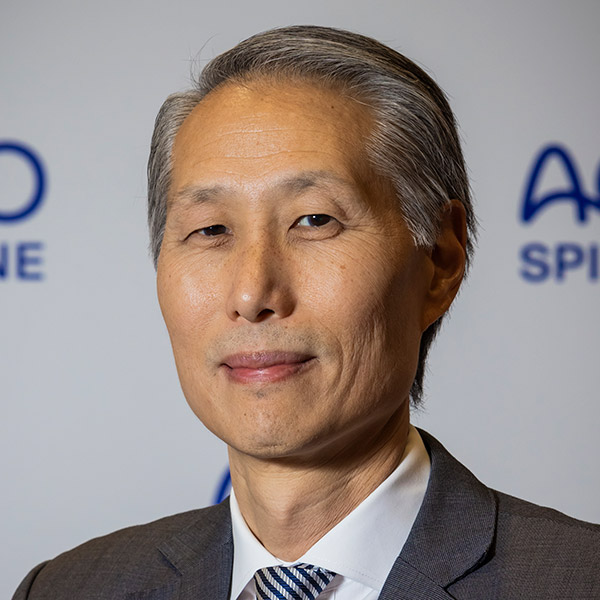Publishing your scientific research: insights from the GSJ
BY KARSTEN WIECHERT, JENS CHAPMAN, AND JEFFREY WANG, GSJ EDITORS-IN-CHIEF

Being published in a respected scientific journal is likely to be among the aspirations of most researchers who engage in clinical research. However, the process required to get there can be daunting, especially for those who are still in the early stages of their careers. Here, the editorial team of the Global Spine Journal (GSJ), the official scientific publication of AO Spine, introduces their journal and shares valuable tips and information relevant to anyone who has ever considered submitting an article to a scientific journal.
Global Spine Journal (GSJ) is an open access, peer-reviewed journal with a focus on the study and treatment of spinal disorders. We pursue a multi-disciplinary scope, and apart from diagnosis, operative and non-operative treatment options, and surgical techniques, we also keep tabs on emerging research and clinical developments.
The articles we feature mostly consist of original research, reviews, commentaries, editorials, and technical reports with relevance for researchers and clinicians who specialize in the spine. We also try to promote communication among spine surgeons, orthopedic surgeons, and neurosurgeons across the globe by providing an integrated and balanced view of the clinical and basic science studies of spinal disorders.
GSJ was founded in the traditional journal format in 2011. However, we adopted the open access publishing model in 2015, which means that all our articles are available to read and download online 30 days after acceptance in Sage Journals' OnlineFirst queue. They are therefore considered fully published and citable prior to their inclusion in a final print and online journal issue.
Over the past few years, GSJ's print edition has grown from four issues per year and 50 submissions to eight issues per year and over 1,000 submissions. This growth is also reflected in the development of our editorial board, which began as a small group and now consists of over 15 deputy editors from regions all over the world.
Our impact factor for 2023 is 2.4, and it has continuously increased in recent years. Our 5-year impact factor is 3.0, and our acceptance rate is 30 percent. GSJ is indexed in PubMed Central (PMC) and the Emerging Science Citation Index (ESCI), as well as SCOPUS and the Directory of Open Access Journals (DOAJ). GSJ is the second highest ranked spine journal.
Why publish with Global Spine Journal?
Authors may choose to publish their papers in the Global Spine Journal for various reasons, and their decision will often depend on their own specific goals and preferences. Of course, chief among the reasons why researchers and professionals may opt to publish with us is our pronounced focus on spine-related research, within which we cover a wide range of topics from basic science to clinical studies. Also, as our very name suggests, the focus of the Global Spine Journal is worldwide. We provide authors with an opportunity to reach an international audience, which can appeal to researchers who want their work to have a broad impact and be accessible to professionals and academics around the world.
Moreover, the field of spine research often involves collaboration between different specialties—for instance orthopedics, neurosurgery, radiology, and rehabilitation. We therefore take an interdisciplinary approach and cover a wide spectrum of spine-related topics, which appeals to authors who are interested in the collaborative aspect of the field.
We also offer authors a robust peer-review system with a rigorous review process. Authors who choose to publish their work with us can rely on the fact that it will be evaluated by proven experts in the field. We take pride in the fact that we considered reputable and trustworthy and enjoy a high regard in the field of spine research. Authors who publish with us can also benefit from this kind of reputation and trust, which may potentially enhance the visibility and impact of their research.
Finally, authors who are affiliated with spine-related professional societies or associations that in turn have a connection with GSJ, it may encourage them to publish in the journal because of these partnerships. Having said that, when deciding where to submit their papers, it is very important that authors carefully consider their research goals, target audience, and the specific focus of their work, and that they inform themselves about the latest developments, impact factor, and policies of the journals they consider.
Who publishes with GSJ?
We aim to publish manuscripts from all professionals and researchers in the fields of spine surgery, spinal medicine, orthopedics, neurosurgery, and related disciplines. For instance, spine specialists such as orthopedic surgeons or neurosurgeons, who specialize in spine surgery, regularly contribute to the journal to share their clinical experiences, surgical techniques, and outcomes. We also often publish the findings of orthopedic and neurological scientists and researchers who conduct studies on various aspects of spine health, including biomechanics, pathology, and treatment outcomes.
Physicians and clinicians who are involved in the diagnosis and management of spinal disorders, including physiatrists, pain management specialists, and rehabilitation experts, also contribute relevant research and clinical insights. Radiology specialists regularly submit articles on advancements in spinal imaging techniques and their application in spine-related conditions.
In addition, articles on the rehabilitation process for individuals with spinal disorders may be contributed by rehabilitation specialists, for instance by physical therapists. Finally, we also publish research into biomechanics and engineering aspects of spine health, such as the design of spinal implants or innovative treatment approaches.
It is however important to note that our specific group of authors may evolve over time, and the journal may attract contributions from a very diverse range of spinal care professionals. To get the most accurate and current information, we recommend that you check our latest guidelines and focus areas and pay a visit to the GSJ's official website.
What type of content works best?
The articles with the most clinical impact will typically be the ones that are read and cited the most. After all, our audience primarily consists of spine surgeons who treat spinal diseases—they want to learn about the latest evidence, the most effective treatments for their patients, and anything that is on the cutting edge of new technology. Articles that provide answers to these questions therefore generally receive the most citations. In addition, our guidelines are also cited often, because they are of high quality. They establish evidence-based best practices for the treatment of certain disorders, and many of our readers find this useful in their practice.
What also works well are articles that focus on the kind of topics that are most commonly being seen and treated by physicians around the world. They tend to get the most interest, and likely also the most citations. And, given the times, there certainly are areas of research that receive more interest than others, such as robotics, navigation, or newer technologies. As a result, more authors publish on these issues, which in turn makes it necessary for them to cite from certain articles. Consequently, if you have authored an article that is of a very interesting topic and that is also very contemporary, it is likely to be cited more often.
Common reasons for rejection
We cannot accept every manuscript submitted to us. In fact, as our acceptance rate shows, we reject more than two articles for every one article we publish. In some cases, the quality of the research may not be high enough. In other cases, articles are rejected simply because they are not formatted correctly. Manuscripts must be presented in a readable fashion, with good English, flow, and grammar. If you are unsure whether your article fulfils all the necessary requirements, you may want to consider working together with a service specializing in professional publication support such as Sage Author Services (see link below). They offer a wide variety of services, including editing, translation, formatting, or plagiarism checks, that will help you get your manuscript ready for publication.
Why publish under the open access model?
One of the most effective ways of promoting and garnering attention for research you have conducted is to publish in an open access (OA) journal such as the Global Spine Journal. Compared to the traditional subscription-based model, this publishing approach offers numerous advantages. Among the key benefits is the free global accessibility of OA content because it ensures that scientific research findings are freely accessible to anyone with an internet connection, regardless of their geographic location, and typically without any cost or subscription barriers. This promotes the global dissemination of knowledge while enhancing its visibility and the impact of research.
OA articles are also more likely to reach a broader audience, including researchers, practitioners, policymakers, and the public. This can lead to increased citations and impact. In addition, OA allows for the rapid dissemination of research findings, which can be crucial in the contexts of public health or emerging scientific developments, where timely access to information is essential. OA also promotes collaboration by removing access barriers. Researchers from different institutions and countries can easily access and build upon each other's work, fostering a collaborative research environment.
It is important to note however that while the OA model has many advantages, it also faces challenges. These include concerns about the sustainability of funding models and the potential for predatory practices.
How to avoid predatory publishers
A word of warning: it is crucial, especially for young and inexperienced authors, to be aware of, and actively avoid, predatory journals. These are publications that exploit the academic publishing process for profit, often engaging in unethical practices. For example, they will sometimes pretend to adhere to the open access publishing model and try to exploit authors by offering to publish their work for a fee, while at the same time neglecting to follow proper academic standards. In general, predatory journals do not provide peer-review processes or editing services. Here is some advice to help authors navigate this issue
Always research the reputation and credibility of any journal you encounter, for example by looking at its website and finding out about its editorial board, review process, and publication policies. Predatory journals often have poorly designed or hastily created websites. Look for professional layout, clear navigation, and comprehensive information, and check for contact information, including valid electronic and physical addresses. Verify a journal's indexing and impact factor by ensuring that it is included in reputable databases and indexes like PubMed, Scopus, or Web of Science. Be cautious of journals that claim to have an impact factor but are not listed in recognized databases.
Also, evaluate the editorial board by checking the credentials and affiliations of its members. Legitimate journals have a board of respected experts in the field. Be especially wary of journals with editorial boards that lack diversity or include individuals with questionable credentials. Assess a publication's peer review system by verifying whether it is transparent and rigorous. Be cautious if a journal claims to have rapid or instant publication without thorough peer review. Look for open access policies: while open access journals can be legitimate, predatory journals often misuse the open access model. Check the journal's open access policies and publication fees. Reputable open access journals disclose their fees transparently and have clear policies regarding licensing and copyright.
It may be a tempting offer, but avoid unsolicited invitations to publish. Reputable journals usually do not send mass emails to solicit submissions. Be cautious of unsolicited messages inviting you to submit a manuscript, and do not submit manuscripts to journals that claim to have reviewed your work without your prior submission. If you are unsure, consult colleagues and mentors and seek advice from more experienced colleagues or supervisors. They can provide insights into reputable journals in your field and help you make informed decisions. Use recognized and trusted publishing directories or lists of reputable journals in your field. Examples include the DOAJ or the Journal Citation Reports.
Lastly, always trust your instincts: if something feels off or if a journal's practices seem questionable, it may be better to err on the side of caution and choose a more reputable publication venue. Remember: the quality of your research is important, and publishing in a reputable journal enhances the impact and credibility of your work. Taking the time to carefully evaluate potential journals can help you avoid falling victim to predatory practices.
Practical information for scientific publishing
If you are a researcher or clinician with a serious ambition to contribute to excellence in spinal disorder treatment, we look forward to hearing from you. To wrap things up, here is some information we recommend you familiarize yourself with if you are considering any submission.
Before submitting original work to us for publication in GSJ, please read carefully through our submission guidelines to ensure your submission fulfils all the necessary formal requirements. Once you have ensured that your work does indeed comply with all listed requirements, you can submit your work via the journal’s submission site.
For a summary of the most important steps on the route towards publication in a scientific journal, please refer to this comprehensive guide on how to get published compiled by our publisher, Sage Publications.
Once your research has appeared in a journal such as GSJ (congratulations!), then will likely want to direct as many readers towards it as possible. Sage Publications have compiled a short list of things you can do to achieve just that.
Finally, we would like to let you know about Sage Author Services. They offer a wide variety of services—editing, translation, formatting, or plagiarism checks, to name a few—to help you get your manuscript ready for publication.
If you are unsure whether a journal or a publisher you come across can be considered predatory, take a look at Beall's List of potential predatory scholarly open‑access publishers and stand-alone journals.
About the authors:
Dr Karsten Wiechert has devoted his entire career to everything related to spinal disorders ever since attending medical school in Berlin, Germany. During his residency and fellowship as an orthopedic surgeon, he underwent a comprehensive surgical training with guidance by his mentor Prof Michael Mayer and pursued a career in spine surgery with focus on minimally invasive techniques. After having chaired a department of spine surgery in Augsburg, Dr. Wiechert stopped performing surgery and refocused on the non-operative treatment of spinal disorders as co-chair of the Spine Center at the Schoen Clinic in Munich, Germany. His key areas of work are interdisciplinary spine care and interventional techniques. He is currently chairing a comprehensive spinal pain program at the Michel Spine Center in Hamburg, Germany. Being involved in numerous official roles with a number of large spine societies and reviewing for several Journals, Dr. Wiechert has been Co-Editor in Chief of the Global Spine Journal since 2012. The active triathlete and sailor lives in Hamburg with his wife.
Professor Jeffrey C. Wang is currently a Professor of Orthopaedic Surgery and Neurosurgery at the Keck School of Medicine at the University of Southern California (USC). He is Co-Director of the USC Spine Center and Fellowship Director of the USC Spine Fellowship. He earned a Bachelor of Science degree in Biological Sciences with honors at Stanford University and his M.D. degree cum laude at the University of Pittsburgh School of Medicine. He did his residency in Orthopaedic Surgery at UCLA and completed a fellowship in Spine Surgery at Case Western Reserve University. In 1997, he joined the David Geffen School of Medicine at UCLA and was named Vice Chair of the Department of Orthopaedic Surgery and was the spine fellowship director since 1997. In 2013, he was recruited to lead the building of the University of Southern California Spine Center. To date, Dr. Wang has published over 600 articles, 23 book chapters, and several textbooks. Moreover, he has made over 1000 presentations regionally and internationally and has been a visiting professor throughout the United States, Europe, and Asia. He has been the honored guest speaker at several international Spine, Orthopaedic, and Neurosurgery Society Meetings. He also serves on multiple editorial boards, and is the Editor-in-Chief of the Global Spine Journal.
He is a Past Chairman of AO Spine, Past President of the North American Spine Society, Past President of the Cervical Spine Research Society, and a Past President of the Society for Brain Mapping and Therapeutics. He has been on the board of directors of several major societies including the North American Spine Society, Cervical Spine Research Society, American Orthopaedic Association, the Society for Brain Mapping and Therapeutics, and is also on the AO Foundation Board. He continues to run a basic science research laboratory and is in full-time academic practice at the University of Southern California.
Dr Jens R. Chapman is an Orthopaedic Spine Surgeon in Seattle, Washington at Swedish Medical Center. He received his medical degree from Technical University Munich Faculty of Medicine and has been in practice for more than 20 years. Dr. Jens R. Chapman has expertise in treating spinal fusion, neck pain and spine problems, among other conditions. Dr. Chapman was the creator of Evidence-Based Spine-Care Journal in 2010, which merged with Global Spine Journal in 2015, and he has been one of the Editors-in-Chief of GSJ ever since. Dr. Chapman has served on the AO North America Board.







